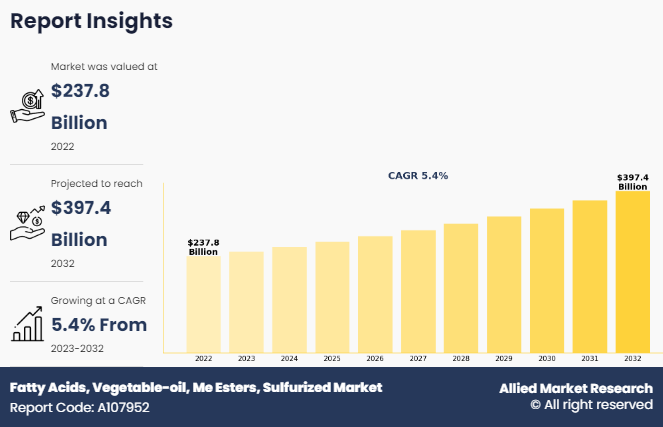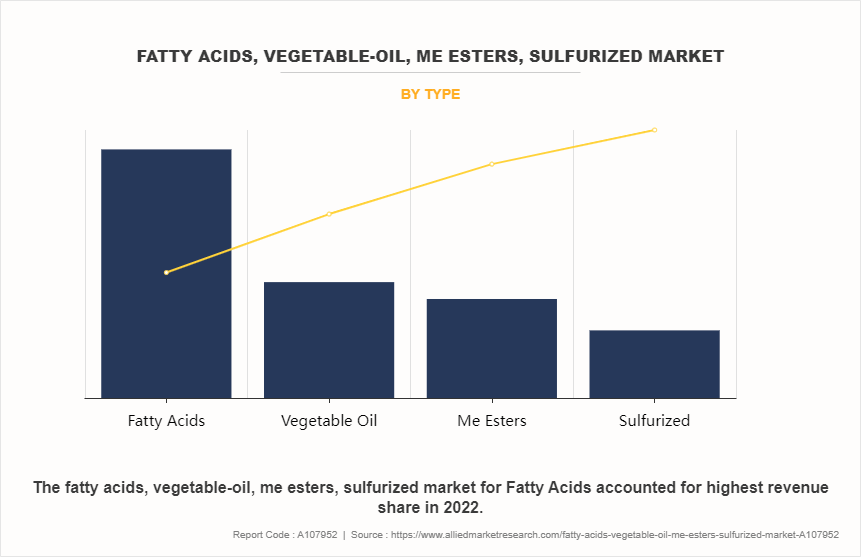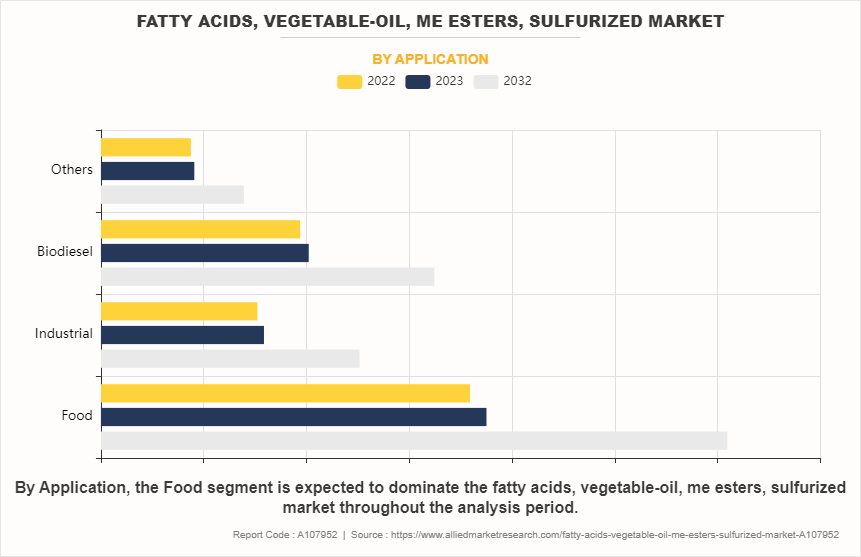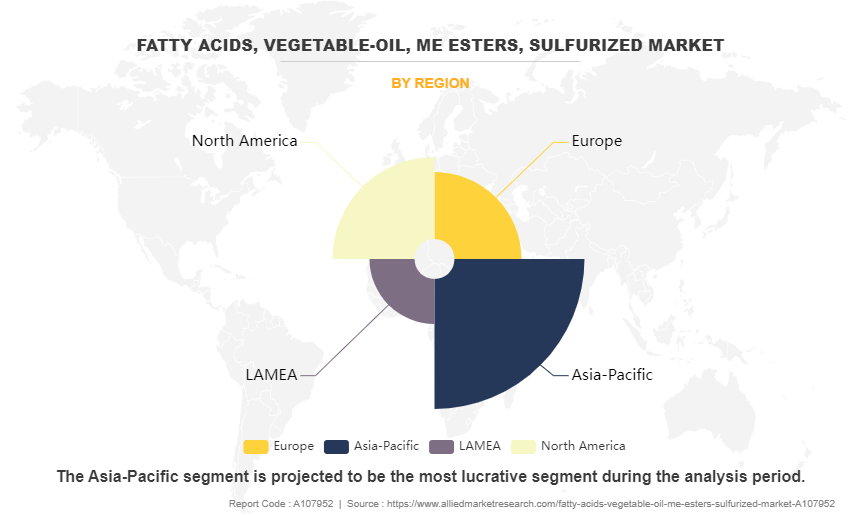Fatty Acids, Vegetable-oil, Me Esters, Sulfurized Market Research, 2032
The global fatty acids, vegetable-oil, me esters, sulfurized market was valued at $237.8 billion in 2022, and is projected to reach $397.4 billion by 2032, growing at a CAGR of 5.4% from 2023 to 2032.The rise in demand for bio-based lubricants and the growing adoption of fatty acids, vegetable oil, methyl esters, and sulfurized derivatives in personal care products is expected to significantly drive the fatty acids, vegetable oils, methyl esters (ME), and sulfurized market.

Introduction
Fatty acids are carboxylic acids with long hydrocarbon chains, typically containing between 4 to 24 carbon atoms. They are fundamental components of lipids, serving as the building blocks of fats and oils. Fatty acids exhibit properties such as being amphiphilic, meaning they have both hydrophilic (water-attracting) and hydrophobic (water-repelling) properties. Vegetable oils, derived from plants, are rich sources of various fatty acids and are commonly used in cooking and industrial applications due to their liquid form at room temperature. Methyl esters are compounds formed by reacting fatty acids with methanol, often utilized in biodiesel production. Sulfurized fatty acid esters are formed by reacting fatty acid esters with sulfur, yielding products with improved lubricating properties, commonly employed in metalworking fluids and lubricants.
Key Takeaways
- Quantitative information mentioned in the global fatty acids, vegetable-oil, me esters, sulfurized market includes the market numbers in terms of value ($Million) and volume (Kilotons) concerning different segments, pricing analysis, annual growth rate, CAGR (2023-32), and growth analysis.
- The analysis in the report is provided on the basis of type, application, and region. The study is expected to contain qualitative information such as the market dynamics (drivers, restraints, opportunities), Porter’s Five Force Analysis, key regulations across the region, and value chain analysis.
- A few companies, including Wilmar International Ltd., Cargill Incorporated, Bunge, ADM, Oleon NV, Musim Mas, and IOI Oleochemical hold a large proportion of the fatty acids, vegetable-oil, me esters, sulfurized market.
- This report makes it easier for existing market players and new entrants to the Fatty Acids, Vegetable-oil, Me Esters, Sulfurized Industry to plan their strategies and understand the dynamics of the industry, which helps them make better decisions.
Market Dynamics
As industries and consumers increasingly prioritize sustainability and environmental responsibility, bio-based lubricants, which are derived from renewable sources such as vegetable oils, are gaining traction. These lubricants offer several advantages over conventional petroleum-based lubricants, including biodegradability, reduced environmental impact, and improved performance in certain applications.
The automotive sector is witnessing surge in the adoption of bio-based lubricants due to stringent emissions regulations and the need for more eco-friendly alternatives. Rise of China's automobile sector is expected to drive up demand for bio-lubricants. China is the world's greatest vehicle producer, according to the International Organization of Motor Vehicle Manufacturers (OICA; French: Organisation Internationale des Constructeurs d'Automobiles). In 2021, the nation produced 2,60,82,220 automobiles. In addition, sales of both commercial and passenger automobiles increased significantly in India. For instance, domestic passenger car sales increased by 13% to 3,069,499 in 2021–2022, as compared to 2020–2021.
In addition, the industrial sector is also embracing bio-based lubricants for various applications, such as metalworking and machinery lubrication, further boosting demand. As a result, the fatty acids, vegetable-oil, Me esters, sulfurized market size is anticipated to witness robust growth in the coming years, driven by rise in demand for bio-based lubricants across diverse industries.
The growing adoption of fatty acids, vegetable oil, methyl esters, and sulfurized derivatives in personal care products is expected to significantly drive the fatty acids, vegetable-oil, Me esters, sulfurized market share. This trend is primarily fueled by increasing consumer preferences for natural and sustainable ingredients in cosmetics, skincare, and hair care products. Vegetable oils, such as coconut, jojoba, and argan oil, are rich in fatty acids and are known for their moisturizing, nourishing, and anti-inflammatory properties, making them ideal ingredients for skincare formulations.
Methyl esters derived from vegetable oils, such as methyl soyate and methyl oleate, are used as emollients and solvents in personal care products. Moreover, sulfurized derivatives of fatty acids, such as sulfurized jojoba oil, are valued for their antimicrobial and antifungal properties, making them suitable for use in anti-acne and anti-dandruff formulations. As consumers increasingly seek natural and sustainable alternatives to synthetic ingredients, the demand for fatty acids, vegetable oil, methyl esters, and sulfurized derivatives in personal care products is expected to continue rising. This trend is further supported by regulatory initiatives promoting the use of renewable and bio-based ingredients in personal care formulations, thus driving the growth of the fatty acids, vegetable-oil, Me esters, sulfurized market analysis.
Millennials are increasingly including beauty goods such as color cosmetics in their daily grooming routines. For example, according to financial comparison service provider Mozo, the average Australian woman will spend around $ 3,600 on cosmetics and personal care items in 2021. The easy availability of these cosmetic items through multiple sales channels, combined with the growing emphasis on personal care, boosted sales value. Furthermore, the introduction of cosmetics with natural, non-toxic, and organic ingredients aided fatty acids, vegetable-oil, Me esters, sulfurized market forecast. With increased awareness of the dangers of chemicals and synthetic products, customers are gravitating toward organic personal care products. It is likely to fuel market expansion during the forecast period.
Health concerns related to the consumption of certain fatty acids and oils, particularly trans fats, have led to stringent regulations and restrictions on their use in food products. Trans fats are known to increase the risk of heart disease and other health issues, prompting governments and health organizations worldwide to limit their presence in food items. This has a direct impact on the market for fatty acids, vegetable oils, methyl esters, and sulfurized products, as many of these products contain or are derived from oils that may contain trans fats.
Manufacturers are now required to reformulate their products to eliminate or reduce trans fats, which can be costly and time-consuming. In addition, consumer awareness of the health risks associated with trans fats has led to a shift in preferences towards healthier alternatives, such as oils high in unsaturated fats like olive oil or canola oil. This has further constrained the market for products containing trans fats, as consumers actively seek out healthier options. As a result, the fatty acids, vegetable-oil, Me esters, sulfurized Market growth may be hampered by these health concerns and the resulting regulatory restrictions and consumer preferences
The growth of the middle-class population, coupled with rising disposable incomes, has fueled the expansion of the middle-class housing segment, thereby propelling residential construction. In the Asia-Pacific region, architectural coatings dominate the market due to the booming construction industry. For example, the Indian government has initiated significant projects in the coming years, such as the Housing for All initiative, aiming to construct over 20 million affordable homes for the urban poor by 2022, which is expected to significantly stimulate residential construction.As the demand for eco-friendly and sustainable paints and coatings continues to rise, the fatty acids, vegetable-oil, Me esters, sulfurized Market Size products is expected to grow significantly, offering lucrative opportunities for manufacturers and suppliers in this sector.
Segment Overview
The fatty acids, vegetable-oil, me esters, sulfurized market is segmented on the basis of type, application, and region. By type, the market is divided into fatty acids, vegetable-oil, me esters, and sulfurized. By application, it is categorized into food, industrial, biodiesel, and others. Region-wise, the market is studied across North America, Europe, Asia-Pacific, and LAMEA.

The fatty acid segment accounted for the largest share in 2022. Several factors contribute to the increasing demand for fatty acids. These include growing awareness of the health benefits associated with omega-3 and omega-6 fatty acids, rising consumer interest in natural and organic products, expanding applications in industries such as food, pharmaceuticals, and personal care, and the growing popularity of plant-based diets. According to the Industry Association for Personal Care and Detergents e. V. (IKW), revenues from laundry detergents and cleaning products in Germany accounted for $ 6,024.60 million (EUR 5,092 million) in 2021, compared to $ 5,989.49 million (EUR 5,246 million) in the previous year.
Vegetable oil is expected to register the highest CAGR of 5.7%. The increasing demand for vegetable oil is driven by several factors. Rising health consciousness among consumers preferring healthier cooking oils. In addition, the expanding food industry, particularly in emerging markets, necessitates higher vegetable oil usage Vegetable oils are currently in great demand due to their use in fuels, dishwashers, and perfume formulations. This is one of the primary drivers of the market's expansion. For example, according to the USDA Foreign Agricultural Service, the volume of leftover cooking oil used as a feedstock for biodiesel fuel production in India in 2021 was 55,000 metric tons, up from 50,000 tons in 2020.

The food segment accounted for the largest share in 2022 and is expected to register the highest CAGR of 5.5%. In food applications, fatty acids, vegetable oils, ME esters, and sulfurized compounds serve various functions. They act as emulsifiers, stabilizers, and preservatives, enhancing texture, flavor, and shelf life in processed foods. Additionally, they are used in frying oils, margarine, and bakery products, contributing to the desired taste and texture while meeting food safety standards.
The expanding paints and coatings industry presents a lucrative opportunity for the growth of fatty acids, vegetable-oil, Me esters, sulfurized Industry. These products are crucial in the formulation of environmentally friendly and sustainable paints and coatings, which are increasingly in demand due to growing environmental concerns. Fatty acids derived from vegetable oils are used as binders and additives in paints and coatings, offering improved durability and adhesion. Methyl esters, derived from vegetable oils, are also used as solvents in paints and coatings, providing low VOC (volatile organic compound) content and reduced environmental impact. Moreover, sulfurized products, such as sulfurized fatty acids, are used as additives in paints and coatings to improve their lubricity and anti-wear properties.

Asia-Pacific garnered the largest share in 2022. The Asia-Pacific market for fatty acids, vegetable oil, ME esters, and sulfurized products is dynamic and rapidly growing. With increasing industrialization and urbanization in the region, there is a rising demand for these products across various sectors such as food, pharmaceuticals, and cosmetics. Additionally, technological advancements and evolving consumer preferences are shaping the market landscape in Asia-Pacific.
India has been witnessing outstanding urbanization and infrastructure development, increasing construction projects. This has directly raised demand for architectural paints used in buildings and structures. The country's residential sector is growing, due to government backing and measures that are driving demand even higher. For example, the Ministry of Housing and Urban Development (MoHUA) budgeted $1,018,659.2 Million (INR 76,549.46 crore) in the 2022-23 budget for house construction and funding to complete stalled projects.
Furthermore, according to Business Today, the government has set aside $10,756.13 Million (INR 80,671 crore) for projects like the Pradhan Mantri Awas Yojana (PMAY) program, which aims to provide affordable housing to many people. In addition, the government provides interest subsidies on housing loans to citizens who want to build or buy their first home. According to the Economic Times, the construction sector rose by 13.3% from July to September 2023 compared to the previous year, up from 7.9% in the previous quarter and its greatest performance in five quarters.
North America experienced robust growth in the commercial construction sector due to substantial investments in the U.S. and Canada. According to the US Census Bureau, construction spending reached $ 1,639.9 billion in December 2021, a 0.2% increase from the revised November estimate of $ 1,636.5 billion. Additionally, 2021 saw construction spending rise to $ 1,589.0 billion, marking an 8.2% increase from 2020, driving up demand for paints and coatings in construction applications.
In Europe, there's been a surge in retail expansion, evident in the construction of new malls across the continent. Notable projects include the Metropol Mall in Turkey, Mall of Scandinavia in Sweden, Westfield Bradford in the United Kingdom, Weberzeile Ried in Austria, Mall of Europe in Belgium, and Lublin Mall in Poland.
Competitive Landscape
The players operating in the global fatty acids, vegetable-oil, me esters, sulfurized market are Wilmar International Ltd., Cargill Incorporated, Bunge, ADM, Oleon NV, Musim Mas, IOI Oleochemical, Kao Corporation, Louis Dreyfus Company, and Pacific Oleochemicals, Sdn. Bhd. Other players include Evonik Industries, BASF SE, Akzo Nobel N.V., KLK Oleo, Procter & Gamble, Dow.
Key Benefits For Stakeholders
- This report provides a quantitative analysis of the market segments, current trends, estimations, and dynamics of the fatty acids, vegetable-oil, me esters, sulfurized market analysis from 2022 to 2032 to identify the prevailing fatty acids, vegetable-oil, me esters, sulfurized market opportunities.
- The market research is offered along with information related to key drivers, restraints, and opportunities.
- Porter's five forces analysis highlights the potency of buyers and suppliers to enable stakeholders make profit-oriented business decisions and strengthen their supplier-buyer network.
- In-depth analysis of the fatty acids, vegetable-oil, me esters, sulfurized market segmentation assists to determine the prevailing market opportunities.
- Major countries in each region are mapped according to their revenue contribution to the global market.
- Market player positioning facilitates benchmarking and provides a clear understanding of the present position of the market players.
- The report includes the analysis of the regional as well as global fatty acids, vegetable-oil, me esters, sulfurized market trends, key players, market segments, application areas, and market growth strategies.
Fatty Acids, Vegetable-oil, Me Esters, Sulfurized Market Report Highlights
| Aspects | Details |
| Market Size By 2032 | USD 397.4 billion |
| Growth Rate | CAGR of 5.4% |
| Forecast period | 2022 - 2032 |
| Report Pages | 251 |
| By Type |
|
| By Application |
|
| By Region |
|
| Key Market Players | IOI Oleochemical, Kao Corporation, Musim Mas, Louis Dreyfus Company B.V., Oleon NV, Cargill Incorporated, Pacific Oleochemicals, Sdn. Bhd, Bunge, ADM, Wilmar International Ltd. |
Analyst Review
According to the insights of the CXOs of leading companies, rise in demand for biofuels and renewable energy sources serves as a significant driver for the market. As governments globally implement policies to reduce greenhouse gas emissions and promote sustainable practices, there is a growing preference for biodiesel, derived mainly from vegetable oils and fatty acid methyl esters (FAME). In addition, sulfurized compounds find application as additives in lubricants and metalworking fluids, supporting industrial growth.
However, the market faces several restraints, including fluctuations in raw material prices, which directly impact production costs. Furthermore, regulatory uncertainties and environmental concerns regarding the sustainability of feedstock sources pose challenges to market expansion.
The CXOs further added that the technological advancements in extraction, refining, and processing techniques enhance the efficiency and quality of fatty acid derivatives, boosting their adoption across diverse sectors. Moreover, expanding applications in cosmetics, pharmaceuticals, and food industries drive the market growth. Strategic collaborations and investments in research and development further fuel innovation, leading to the discovery of novel applications and formulations. In addition, the rising trend towards green chemistry and eco-friendly solutions propels the demand for sustainable alternatives, driving market growth for fatty acids, vegetable oils, methyl esters, and sulfurized compounds.
The fatty acids, vegetable-oil, me esters, sulfurized market attained $237.8 billion in 2022 and is projected to reach $397.4 billion by 2032, growing at a CAGR of 5.4% from 2023 to 2032.
The fatty acids, vegetable-oil, me esters, sulfurized market is segmented on the basis of type, application, and region. By type, the market is divided into fatty acids, vegetable-oil, me esters, and sulfurized. By application, it is categorized into food, industrial, biodiesel, and others. Region-wise, the market is studied across North America, Europe, Asia-Pacific, and LAMEA.
The rise in demand for bio-based lubricants and the growing adoption of fatty acids, vegetable oil, methyl esters, and sulfurized derivatives in personal care products are the drivers of the of the Fatty Acids, Vegetable-oil, Me Esters, Sulfurized Market.
Food is the leading application of Fatty Acids, Vegetable-oil, Me Esters, Sulfurized Market.
Expanding paints and coatings industry is the upcoming trend of Fatty Acids, Vegetable-oil, Me Esters, Sulfurized Market in the world.
Wilmar International Ltd., Cargill Incorporated, Bunge, ADM, Oleon NV, Musim Mas, and IOI Oleochemical are the top companies to hold the market share in Fatty Acids, Vegetable-oil, Me Esters, Sulfurized.
The rise in demand for bio-based lubricants and the growing adoption of fatty acids, vegetable oil, methyl esters, and sulfurized derivatives in personal care products are the drivers of the of the Fatty Acids, Vegetable-oil, Me Esters, Sulfurized Market.
Loading Table Of Content...
Loading Research Methodology...



